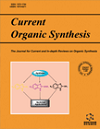- Home
- A-Z Publications
- Current Organic Synthesis
- Previous Issues
- Volume 18, Issue 8, 2021
Current Organic Synthesis - Volume 18, Issue 8, 2021
Volume 18, Issue 8, 2021
-
-
Molecular Descriptors of Some Chemicals that Prevent COVID-19
More LessAuthors: Sourav Mondal, Nilanjan De, Anita Pal and Wei GaoBackground: Topological index is a numerical molecular descriptor that plays an important role in structure-property/structure-activity modeling. A large number of works on multiplicative degree based indices have been developed. However, no attention is paid to investigating their chemical significance. Investigation of the chemical importance of such indices is needed. The computation of topological indices for different che Read More
-
-
-
Computing Analysis of Degree and Connection Based Irregular Indices of Polycyclic Aromatic Hydrocarbons
More LessAuthors: Muhammad Javaid, Muhammad Ibraheem and Abdul RaheemIntroduction: A graph is supposed to be regular if all vertices have equal degree, otherwise irregular. Materials and Methods: Polycyclic aromatic hydrocarbons are important combusting material and considered as a class of carcinogens. These polycyclic aromatic hydrocarbons play an important role in graphitisation of medical science. A topological index is a function that assigns a numerical value to a (molecular) grap Read More
-
-
-
Computation and Analysis of Topological Co-Indices for Metal-Organic Compound
More LessA topological descriptor is a mathematical illustration of a molecular construction that relates particular physicochemical properties of primary molecular structure as well as its mathematical depiction. Topological co-indices are usually applied for quantitative structure action relationships (QSAR) and quantitative structure property relationships (QSPR). Topological co-indices are topological descriptor which consider the no Read More
-
-
-
Recent Opportunities and Challenges in Selective C-H Functionalization of Methyl Azaarenes: A Highlight from 2010 to 2020 Studies
More LessAuthors: Fahimeh Abedinifar, Mohammad Mahdavi, Mehdi Asadi, Haleh Hamedifar, Samira Ansari and Bagher LarijaniAzaarenes are unique scaffolds that are frequently found in pharmaceuticals. Herein we have summarized the recent synthetic available methods in C–H functionalization of methylazaarenes from 2010 to 2020. Multiple approaches involving halogenation, alkylation via different methods, alkenylation, oxidative functionalization, and cyclization of the methylazaarenes will be discussed in this review.
-
-
-
Synthetic and Biological Attributes of Pyrimidine Derivatives: A Recent Update
More LessAuthors: Meenu Devi, Shivangi Jaiswal, Sonika Jain, Navjeet Kaur and Jaya DwivediNitrogen-containing heterocycles attract the attention of chemists due to their multifarious activities. Amongst all, pyrimidine plays a central role and exhibits a broad spectrum of biological activities. Literature is replete with various aspects of synthetic development in the chemistry of pyrimidine for a wide array of applications. It aroused our interest to compile various novel and efficient synthetic approaches towards t Read More
-
-
-
Recent Advances in C-C/Heteroatom Bond Forming and Annulation Reactions of β- Ketodithioesters
More LessAuthors: Laishram M. Devi, Thokchom P. Singh and Okram M. Singhβ-Ketodithioesters (KDEs) are versatile building blocks for the rapid construction of various heterocyclic compounds. Quite a good number of successful reactions based on KDEs have been developed in the past decade for the construction of heterocyclic skeletons under mild conditions. This review covers the new CC/ X bond formation and annulation reactions of KDEs with dielectrophilic or dinucleophilic reagents. Multic Read More
-
-
-
Comparison of Conventional and Microwave Synthesis of Phenyl-1H-pyrazoles and Phenyl-1H-pyrazoles-4-carboxylic Acid Derivatives
More LessBackground: Privileged scaffolds are of high importance for molecules containing the pyrazole subunit due to their broad spectrum of pharmacological activities. For this reason, a method that is more efficient needs to be developed for the preparation of pyrazole derivatives. Objective: The purpose of this study was the optimisation of the conventional synthesis of the pyrazole ring and the oxidation of phenyl- Read More
-
-
-
Green Synthesis of Fused Chromeno-pyrazolo-phthalazine Derivatives with Silicasupported Bismuth Nitrate under Solvent-free Conditions
More LessAuthors: Afroz Aslam, Mehtab Parveen, Kushvendra Singh and Mohammad AzeemAim: The study aimed to synthesize chromeno-pyrazolo[1,2-b]phthalazine-6,9,14(7H)-trione analogs with the help of silica-supported bismuth nitrate catalyst. Background: Nitrogen-containing heterocyclic compounds are widespread, and their applications to pharmaceuticals, agrochemicals, and functional materials are becoming more and more important. Pyrazoles are an important class of compounds for n Read More
-
Volumes & issues
-
Volume 22 (2025)
-
Volume 21 (2024)
-
Volume 20 (2023)
-
Volume 19 (2022)
-
Volume 18 (2021)
-
Volume 17 (2020)
-
Volume 16 (2019)
-
Volume 15 (2018)
-
Volume 14 (2017)
-
Volume 13 (2016)
-
Volume 12 (2015)
-
Volume 11 (2014)
-
Volume 10 (2013)
-
Volume 9 (2012)
-
Volume 8 (2011)
-
Volume 7 (2010)
-
Volume 6 (2009)
-
Volume 5 (2008)
-
Volume 4 (2007)
-
Volume 3 (2006)
-
Volume 2 (2005)
-
Volume 1 (2004)
Most Read This Month
Article
content/journals/cos
Journal
10
5
false
en


